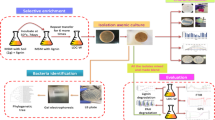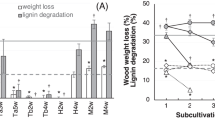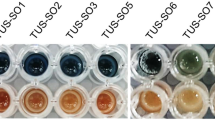Abstract
As an approach to evaluate the contribution of bacteria to lignin degradation in wood, we have chosen to study these microorganisms in the natural wood decay ecosystem known as Palo Podrido. Initially, the characterization of bacteria able to metabolize lignin-related compounds present in samples of Palo Podrido was undertaken. For their isolation, minimal salt media containing lignin dimers of either the arylglycerol-β-aryl ether (β-O-4) or 1,2-diarylpropane (β-1) types as the only source of carbon and energy were inoculated with various wood samples exhibiting different degrees of decay. The β-1 dimers used failed to support bacterial growth. However, three bacterial consortia able to consume quantitatively the β-O-4 model 1-[3,4-dimethoxyphenyl]-2-[2-methoxyphenoxy]-3-hydroxypropanone (compound 1) were isolated. One of these was further characterized. It is composed of eight strains belonging to the families of Streptomycetaceae, Dermatophilaceae and Actinoplanaceae. HPLC and GC-MS analyses revealed that the consortium utilizes two pathways to degrade β-O-4 dimers, both involving direct cleavage of the ether linkage. The formation of a novel C6−C3 degradation intermediate is described. Some metabolic properties of each strain, as well as those of the intact consortium, are also reported.
Similar content being viewed by others
References
AdlerE, LindgrenBO, SaedenU (1952) The β-guaiacyl ether of α-veratrylglycerol as a lignin model. Svensk Papperstidn 15: 245–253
AgosinE, BlanchetteRA, SilvaH, LapierreC, CeaseKR, IbachRE, AbadA, MugaP (1990) Characterization of Palo Podrido: a natural process of delignification in wood. Appl Environ Microbiol 56: 65–74
BennerR, NewellS, MaccubbinE, HodsonR (1984) Relative contributions of bacteria and fungi to rates of degradation of lignocellulosic detritus in salt-marsh sediments. Appl Environ Microbiol 48: 36–40
BennerR, MoranMA, HodsonRE (1986) Biogeochemical cycling of lignocellulosic carbon in marine and freshwater ecosystems: relative contributions of procaryotes and eucaryotes. Limnol Oceanogr 31: 89–100
BlandCE, CouchJN (1981) The familiy Actinoplanaceae. In: StarrMP, StolpH, TruperHG, BalowsA, SchlegelHG (eds) The prokaryotes. Springer Berlin Heidelberg New York, Vol. II, pp 2004–2010
BuchananRE, GibbonsNE (1974) Bergey's manual of determinative bacteriology 8th edn. Williams and Wilkins, Baltimore, USA
CrawfordDL (1981) Microbial conversion of lignin to useful chemicals using a lignin-degrading Streptomyces. Biotechnol. Bioeng. Symp 11: 275–291
DanielG, NilssonT, SinghA (1987) Degradation of lignocellulosics by unique tunnel-forming bacteria. Can J Microbiol. 33: 943–948
DillI, KraepelinG (1986) Palo Podrido: model for extensive delignification of wood by Ganoderma applanatum. Appl Environ Microbiol 52: 1305–1312
ErikssonKE, KolarMC, LjungquistPO, KringstadKP (1985) Studies on microbial and chemical conversions of chlorolignins. Environ Sci Technol 19: 1219–1224
GonzálezA, GrinsbergJ, GrivaE (1986) Biological transformation of wood into feed for cattle-Pado Podrigo, Zentralbl Mikrobiol 141: 181–186
GonzálezB, MerinoA, AlmeidaM, VicuñaR (1986) Comparative growth of natural bacterial isolates on various lignin-related compounds. Appl Environ Microbiol 52: 1428–1432
GonzálezB, OlaveI, CalderónI, VicuñaR (1988) Degradation of diarylethane structures by Pseudomonas fluorescens biovar I. Arch Microbiol 149: 389–394
GonzálezA, MartinezA, AlmendrosG, GrinsbergJ (1989) A study of yeasts during the delignification and fungal transformation of wood into cattle feed in chilean rain forest. Antonie van Leeuwenhock 55: 231–236
HiltonM, CainW (1990) Bioconversion of cinnamic acid to acetophenone by a pseudomonad: microbial production of a natural flavor compound. Appl Environ Microbiol 56: 623–627
KirkTK, FarrellR (1987) Enzymatic “combustion”: the microbial degradation of lignin. Ann Rev Microbiol 412: 465–505
KondoR, IlmoriT, ImamuraH (1988a) Enzymatic synthesis of glucosides of monomeric lignin model compounds with commertial β-glucosidase. Mokuzai Gakkaishi 34: 724–731
KondoR, IlmoriT, ImamuraH (1988b) Bioconversion of a lignin model compound into its glucoside during the hydrolysis of cellobiose by mycelia of wood-rotting fungi. Mokuzai Gakkaishi 36: 501–505
KutznerHJ (1981) The family Streptomycetaceae. In: StarrMP, StolpH, TruperHG, BalowsA, SchlegelHG (eds). The prokaryotes. Springer Vol. II, Berlin Heidelberg New York, pp 2028–2090
LanducciLL, GeddesSA, KirkTK (1981) Synthesis of 14C-labeled 3-methyoxy-4-hydroxy-α-(2-methoxyphenoxy)-β-hydroxypropiophenone, a lignin model compound. Holzforschung 35: 67–70
LuedemannGM (1968) Geodermatophilus: a new genus of the Dermatophilaceae (Actinomycetales). J Bacteriol 196: 1848–1858
LundquistK, KirkTK (1980) Fractionation-purification of an industrial Kraft lignin. Tappi J 63: 80–82
MartńezAT, BarrasaJM, PrietoA, BlancoMN (1991) Fatty acid composition and taxonomic status of Ganoderma australis from southern Chile Mycol Res 95: 782–784
NeilsonAH, LindgrenC, HynningP-A, RembergerM (1988) Methylation of halogenated phenols and thiophenols by cell extracts of gram-positive and gram-negative bacteria. Appl Environ Microbiol 54: 524–530
PhillippiF (1893) Die Pilze Chiles, soweit dieselben als Nahrungsmittel gebraucht werden. Herdwigia 32: 115–118
RamachandraM, CrawfordD, HertelG (1988) Characterization of an extracellular lignin peroxidase of the lignocellulolytic actinomycete Streptomyces viridosporus. Appl Environ Microbiol 54: 3057–3063
RobertsDS (1981) The family Dermatophilacaea. In: StarrMP, StolpH, TruperHG, BalowsA, SchlegelHG (eds) The prokaryotes. Springer Vol. II, Berlin Heidelberg New York, pp 2011–2015
RüttimannC, SeelenfreundD, VicuñaR (1987) Metabolism of low molecular weight lignin-related compounds by Streptomyces viridosporus T7A. Enzyme Microbial Technol 9: 526–530
RüttimannC, VicuñaR, MozuchM, KirkTK (1991) Limited bacterial mineralization of fungal degradation intermediates of synthetic lignin. Appl. Environ Microbiol 57: 3652–3655
SamejimaM, SaburiY, YoshimotoT, FukuzumiT, NakazawaT (1985) Catabolic pathway of guaiacylglycerol-β-guaiacyl ether by Pseudomonas sp. TMY 1009. Mokuzai Gakkaishi 31: 956–958
Samejima M, Abe S, Habu N, Tatarazako N, Yoshimoto T (1987) Biodegradation pathway and mechanism of lignin-related compounds with β-aryl ether linkage by Pseudomonas paucimiobilis TMY 1009. Abstracts of the Fourth International Symposium on Wood and Pulping Chemistry, Paris. pp 297–300
SeelenfreundD, LapierreC, VicuñaR (1990) Production of soluble lignin-rich fragments (APPL) from wheat lignocellulose by Streptomyces viridosporus and their partial metabolism by natural bacterial isolates. J Biotechnol 13: 145–158
SinghAP, DrysdaleJA, ButcherJA (1988) Transmission electron microscopic evidence of the wood degrading activity of actinomycete-like organisms. Holzforschung 42: 277–279
TienM, KerstenPJ, KirkTK (1987) A potential strategy for selecting and improving lignin-degrading microbes based on lignin model aminoacid adducts. Appl Environ Microbiol 53: 242–245
TienM, MyerS (1990) Selection and characterization of mutants of Phanerochaete chrysosporium exhibiting ligninolytic activity under nutrient-rich conditions. Appl Environ Microbiol 56: 2540–2544
VicuñaR, GonzálezB, MozuchM, KirkTK (1987) Metabolism of lignin model compounds of the arylglycerol-β-aryl ether type by Pseudomonas acidovorans D3. Appl Environ Microbiol 53: 2605–2609
VicuñaR (1988) Bacterial degradation of lignin. Enzyme Microbial Technol 10: 645–708
VicuñaR, GonzálezB, SalasL (1990) Metabolism of lignin-related dimeric structures by Pseudomonas fluorescens biovar I. In: KirkTK, ChangHM (eds) Biotechnology in pulp and paper manufacture. Butterworth-Heinemann, Boston, pp 505–512
WaksmannSA (1961) The actinomycetes, vol. II. Williams and Wilkins, Baltimore, USA, pp 327–334
WaksmannSA (1967) The actinomycetes. A summary of current knowledge. Ronald Press, New York
ZimmermannW, UmezawaT, BrodaP, HiguchiT (1988) Degradation of a non-phenolic arylglycerol-β-aryl ether by Streptomyces cyaneus. FEBS Lett 239: 5–7
ZimmermannW (1990) Degradation of lignin by bacteria. J Biotechnol 13: 119–130
Author information
Authors and Affiliations
Rights and permissions
About this article
Cite this article
Céspedes, R., Salas, L., Calderón, I. et al. Microbial and biochemical characterization of a bacterial consortium isolated from decaying wood by growth on a β-O-4 lignin-related dimeric compound. Arch. Microbiol. 158, 162–170 (1992). https://doi.org/10.1007/BF00290811
Received:
Accepted:
Issue Date:
DOI: https://doi.org/10.1007/BF00290811




